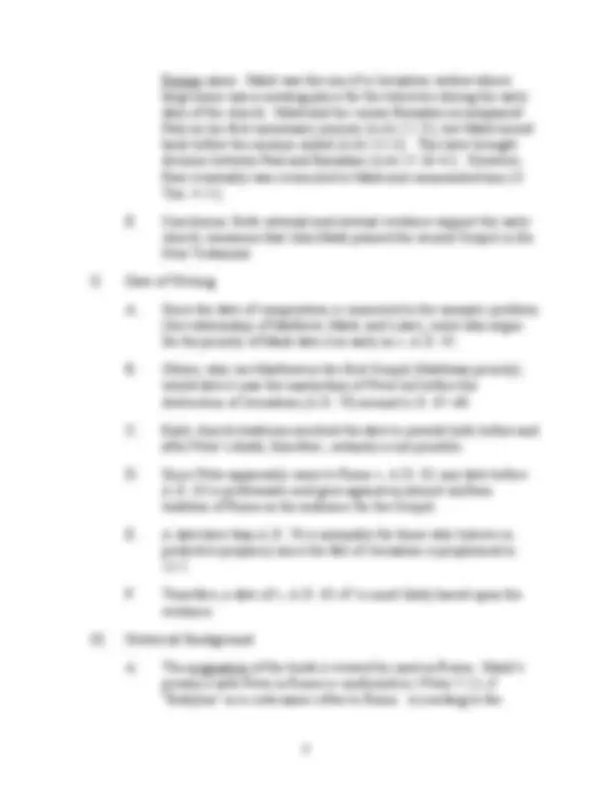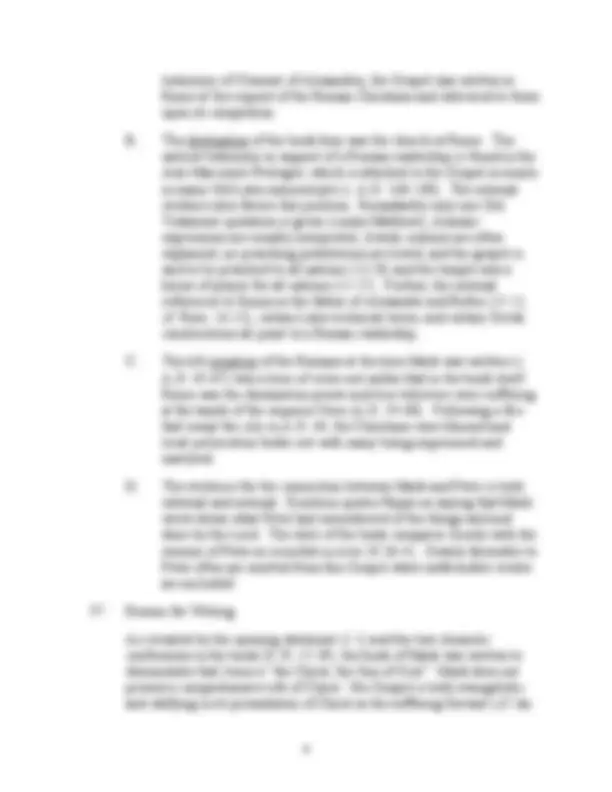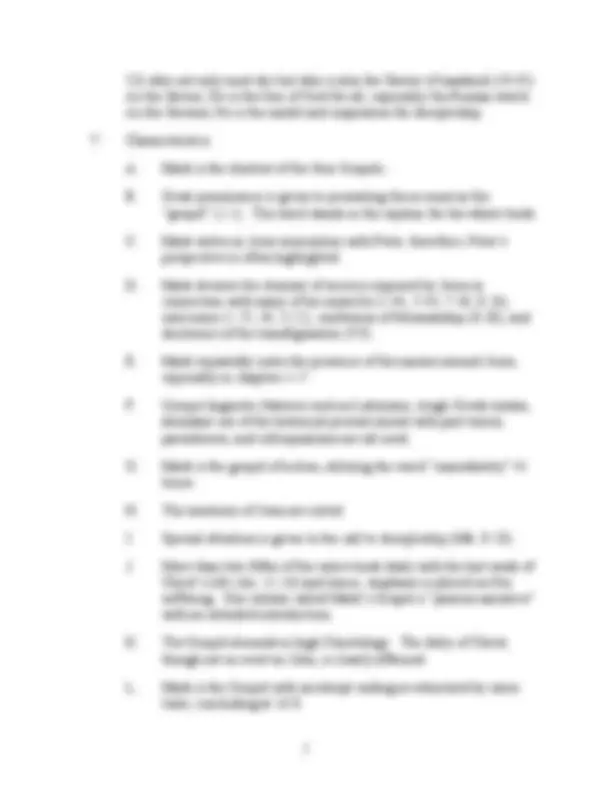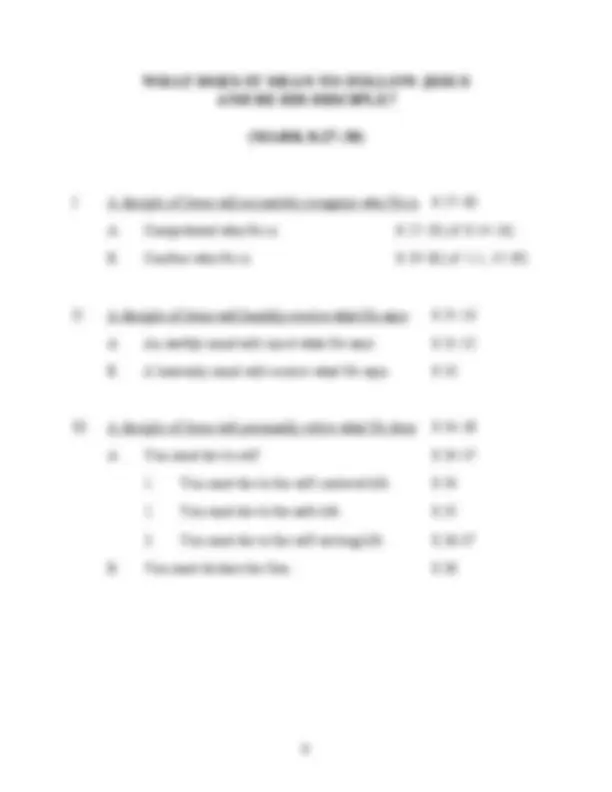






Study with the several resources on Docsity

Earn points by helping other students or get them with a premium plan


Prepare for your exams
Study with the several resources on Docsity

Earn points to download
Earn points by helping other students or get them with a premium plan
Community
Ask the community for help and clear up your study doubts
Discover the best universities in your country according to Docsity users
Free resources
Download our free guides on studying techniques, anxiety management strategies, and thesis advice from Docsity tutors
The authorship of the Gospel of Mark, focusing on the evidence supporting Markan authorship and the role of Peter. Additionally, the document discusses the date of writing, reason for writing, and characteristics of the Gospel, including its emphasis on the Son of Man and the suffering servant. The document also touches upon the significance of the title 'Son of Man' in Mark.
What you will learn
Typology: Exams
1 / 8

This page cannot be seen from the preview
Don't miss anything!





1:1 “THE BEGINNING OF THE GOSPEL OF JESUS THE CHRIST.. .THE SON OF GOD”
CHAPTERS 1—8 CHAPTERS 8—10 CHAPTERS 11—
Sent to the Multitudes Servant to the Disciples Sacrifice for the World
Deity Discipleship Death
Christ’s Power Christ’s Principles Christ’s Passion
Key verse of Mark: Mark 10:45 “For the Son of Man did not come to be served but to serve...
and to give His life as a ransom for many.”
8:29 15:
Purpose Statement for the Gospel of Mark:
Mark recorded in rapid succession specific events from the life and ministry of Jesus Christ to present the gospel to a Roman audience, proving that Jesus is the Christ, the Son of God, and to provide a pattern of discipleship through the model of the suffering servant climaxing in His passion.
I. The Author
A. The inscription Kata Markon (according to Mark) at the beginning of the earliest manuscripts reveals the view of the early church. The early church never ascribed authorship of the second Gospel to anyone other than Mark.
B. The external evidence for a Markan authorship is both early and strong. The Church Fathers such as Papias, Justin Martyr, Irenaeus, the Muratorian Fragment, Tatian’s Diatessaron, Clement of Alexander, Tertullian, and Origen, Eusebius all affirm Mark as the author.
C. Although the author is not named in the book (technically the Gospel is anonymous), there are indications (internal evidence) that support Markan authorship.
D. Mark’s name appears eight times in the New Testament (Acts 12:12, 25; 13:5, 13; 15:37-39; Col. 4:10; II Tim. 4:11; Philemon 23, 24; I Pet. 5:13). John was his Jewish name and Mark was his
testimony of Clement of Alexandria, the Gospel was written in Rome at the request of the Roman Christians and delivered to them upon its completion.
B. The destination of the book then was the church at Rome. The earliest testimony in support of a Roman readership is found in the Anti-Marconite Prologue, which is attached to the Gospel accounts in many Old Latin manuscripts (c. A.D. 160-180). The internal evidence also favors this position. Remarkably only one Old Testament quotation is given (contra Matthew), Aramaic expressions are usually interpreted, Jewish customs are often explained, no preaching prohibitions are listed, and the gospel is said to be preached to all nations (13:20) and the temple was a house of prayer for all nations (11:17). Further, the internal references to Simon as the father of Alexander and Rufus (15:21; cf. Rom. 16:13), certain Latin technical terms, and certain Greek constructions all point to a Roman readership.
C. The life situation of the Romans at the time Mark was written (c. A.D. 65-67) was a time of crisis not unlike that in the book itself. Rome was the domination power and true believers were suffering at the hands of the emperor Nero (A.D. 54-68). Following a fire that swept the city in A.D. 64, the Christians were blamed and local persecution broke out with many being imprisoned and martyred.
D. The evidence for the connection between Mark and Peter is both external and internal. Eusebius quotes Papias as saying that Mark wrote down what Peter had remembered of the things said and done by the Lord. The style of the book compares closely with the sermon of Peter as recorded in Acts 10:36-41. Details favorable to Peter often are omitted from this Gospel while unfavorable events are included!
IV. Reason for Writing
As revealed by the opening statement (1:1) and the two climactic confessions in the book (8:29; 15:39), the book of Mark was written to demonstrate that Jesus is “the Christ, the Son of God.” Mark does not present a comprehensive life of Christ. His Gospel is both evangelistic and edifying in its presentation of Christ as the suffering Servant (cf. Isa.
V. Characteristics
A. Mark is the shortest of the four Gospels.
B. Great prominence is given to presenting the account as the “gospel” (1:1). The word stands in the caption for the whole book.
C. Mark writes in close association with Peter; therefore, Peter’s perspective is often highlighted.
D. Mark stresses the element of secrecy imposed by Jesus in connection with many of his miracles (1:44; 5:43; 7:36; 8:26), exorcisms (1:25, 34; 3:12), confession of Messiahship (8:30), and disclosure of the transfiguration (9:9).
E. Mark repeatedly notes the presence of the masses around Jesus, especially in chapters 1–7.
F. Unique linguistic features such as Latinisms, rough Greek syntax, abundant use of the historical present mixed with past tenses, parentheses, and colloquialisms are all used.
G. Mark is the gospel of action, utilizing the word “immediately” 41 times.
H. The emotions of Jesus are noted.
I. Special attention is given to the call to discipleship (Mk. 8-10).
J. More than two-fifths of the entire book deals with the last week of Christ’s life (chs. 11-16) and hence, emphasis is placed on His suffering. One scholar called Mark’s Gospel a “passion narrative” with an extended introduction.
K. The Gospel abounds in high Christology. The deity of Christ, though not as overt as John, is clearly affirmed.
L. Mark is the Gospel with an abrupt ending as witnessed by some texts, concluding at 16:8.
The title “Son of Man” is found sixty-nine times in the Gospels and fourteen times in Mark. It is clearly Jesus’ favorite way to refer to Himself. Why did Jesus use this term so often and what did He mean by it? Why did He not use more often the term “Christ” or “Messiah” since that is truly what He is? A look at the way the term is used can help answer those questions.
The title “Son of Man” is used in the Old Testament variously. In Psalm 144:3 it simply means “man.” However, in Daniel 7:13-14 it refers to One who will come with the clouds of heaven to establish God’s kingdom. Jesus uses the title to refer to Himself with both connotations. As God incarnate, He is a man who identifies with humanity as He serves and suffers on his behalf. As God, He is the coming Lord of Glory. Jesus avoided the term “Christ” (Messiah) because the popular concept of Messiah was far different than His true mission. He was a different kind of Messiah than the Jewish nation anticipated. He first came to suffer and then He would come in glory. This title allowed Him to refer to the total scope of His Messianic mission without all the political overtones of His day. It is interesting to note the title appears very infrequently outside the four Gospels.
I. A disciple of Jesus will accurately recognize who He is. 8:27-
A. Comprehend who He is. 8:27-28 (cf. 8:14-26)
B. Confess who He is. 8:29-30 (cf. 1:1; 15:39)
II. A disciple of Jesus will humbly receive what He says. 8:31-
A. An earthly mind will reject what He says. 8:31-
B. A heavenly mind will receive what He says. 8:
III. A disciple of Jesus will personally relive what He does. 8:34-
A. You must die to self 8:34-
B. You must declare the Son. 8: